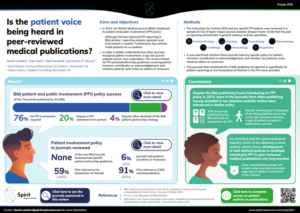We believe that patient input into scientific events, like the European Lupus Meeting or EULAR, is incredibly important. Our hope was that by watching our Webinar on “How to make a scientific poster” by Simon Stones you would get the tools and know how to create a poster for those events! Simon Stones has a wealth of experience in creating and presenting posters for patient organisations at big scientific events! If you missed this Webinar, you still have time to catch up by following this link: https://www.facebook.com/LupusEurope/videos/1334899316855679/
The webinar was so successful that we caught up again with Simon a few months later and asked him a number of follow-up questions! He very kindly gave us his time and this Q&A is the result. We hope you will find it as interesting as we did!
- Is there a main/common topic you have noticed patients tend to have when they want to create a scientific poster?
Historically, most patient-authored posters have focused on patient organisation activities and/or projects. For example, the development of an educational resource, or an awareness raising campaign. At conferences and congresses, such as the EULAR Congress, these tend to be submitted to the ‘PARE’ programme (short for people with arthritis/rheumatism in Europe), and have been quite different to traditional scientific posters, in terms of content, style, and quality. Some have certainly been more engaging and interesting than traditional scientific posters, while others have been weaker in terms of the content quality, which can negatively impact on the credibility of the work. This is certainly no criticism, as we must remember that patients receive no training in creating and disseminating information in this way, unlike researchers, which is why training and support to patient authors is so important. It is worth noting, however, that over the last few years, I have seen an increasing number of posters where patients are co-authors with researchers and clinicians on research-related posters, which is a really positive step as we continue to bridge the gap between patients and researchers/clinicians.
- Can a scientific poster be about a project, for example about the use of sunscreen in SLE patients?
Absolutely, as long as the project has some clear aims. Before I go into the details, I find it helpful to think of there being two kinds of posters – the aim of both is to inform and educate others. The first is the marketing poster used to convey a message, like the ‘stay at home’ posters we’ve seen during the COVID-19 pandemic. They are intended to give a clear message, often with a call to action (e.g., stay at home, get tested, or accept your vaccination). The second is the scientific poster, which is used to summarise the details of a specific project or initiative. Traditional scientific posters follow a conventional layout of different sections. These start with the introduction/background (setting the scene for the topic, and why the research/initiative was needed), the aim/objective (what you set out to do), the methods (what was done), the results (what happened), and the discussion/conclusion (what does this mean). However, this is often a completely new approach for patient organisations, though I always recommend you follow the layout. You will have to do so when submitting an abstract to be considered at conferences and congresses.
So, let’s go back to the fictious example of using sunscreen in people with SLE. The project aimed to understand why people with SLE don’t consistently use sunscreen throughout the year and develop a resource to increase uptake (aim), since it is known that ultraviolet light can trigger a lupus flare in at least 60% of patients (background). The patient organisation partnered with qualitative researchers at a university and clinicians at one of the specialist lupus centres to conduct a series of focus groups with patients and their caregivers. The focus groups explored the reasons why people did and did not use sunscreen (methods). The focus groups showed that people were unaware that they should be using sunscreen all year when exposed to ultraviolet light and had not been advised on the most appropriate sunscreen to use. Others also had concerns over the expense of frequent sunscreen use (results). From this, a new resource was developed to prompt clinicians in taking to patients about the use of sunscreen use and prescribing sunscreen, and one was developed to inform and educate patients about the importance of sunscreen (discussion/conclusion).
The poster needs to have this ‘structure’ to help guide the reader on a journey of what your project was about!
- What was the first scientific poster and/or abstract you submitted? What would you change in retrospect
The first poster I was involved with was back in 2014 for the UK’s public involvement conference, INVOLVE. I was co-author on a research project looking at mobile apps for young people with long-term health conditions. I was keen that the poster ‘looked’ different to other posters and pushed for a mobile phone appearance to make it stand out, though constrained slightly by the convention of traditional posters coming from an academic institution. In hindsight, I would have been much more vocal about what were the key points to be portrayed, and the style in which they should be presented. This is much easier to say now with years of experience and insights into what makes a good poster! I have also learned that a good poster is just half of the story – dissemination online, and engaging people face-to-face (when that used to happen) is just as important… you’ve got to remember that your poster is a bridge between people passing by, and them engaging in a conversation with you about your work.
- Which is your favourite scientific poster that you have made?
Each of the posters that I have made, or been involved in creating as a co-author, has been a proud achievement! One which I co-authored earlier in 2021 is shown below, on the topic of the patient voice in peer-reviewed medical publications. With the switch to virtual congresses, we have adapted to be creative with the poster format. Historically, you had one poster layout, and paper copies for people to take home. Now, while the one poster layout remains, you can add QR codes linking to websites with more content (e.g., videos, audio recordings), and even upload multiple page posters, with hyperlinks from the first page of the poster to different sections (though this is only available on certain conference poster platforms). With this one, I just love the style of the poster, which conveys lots of important information, in quite a visual and enticing manner.

- What is your favourite scientific poster that someone else has created?
I don’t think I can pick a favourite! I do, however, have some favourite styles which I’ve picked up over the years. The #betterposter design has picked up traction in recent years, where the poster consists of a main finding, in big type, plain language and with appropriate visual prompts; a side bar of useful and relevant data; and another side bar with bullet points introducing the study, its methods and results. The best posters are those which are memorable and entice you to ‘find out more’. Interestingly, many of the most memorable ones have been those presented by patient authors – not just because of their design, but because of the storytelling that presenters provide alongside the poster, which is just as important as the design itself!
[/vc_column_text][/vc_column][/vc_row]



